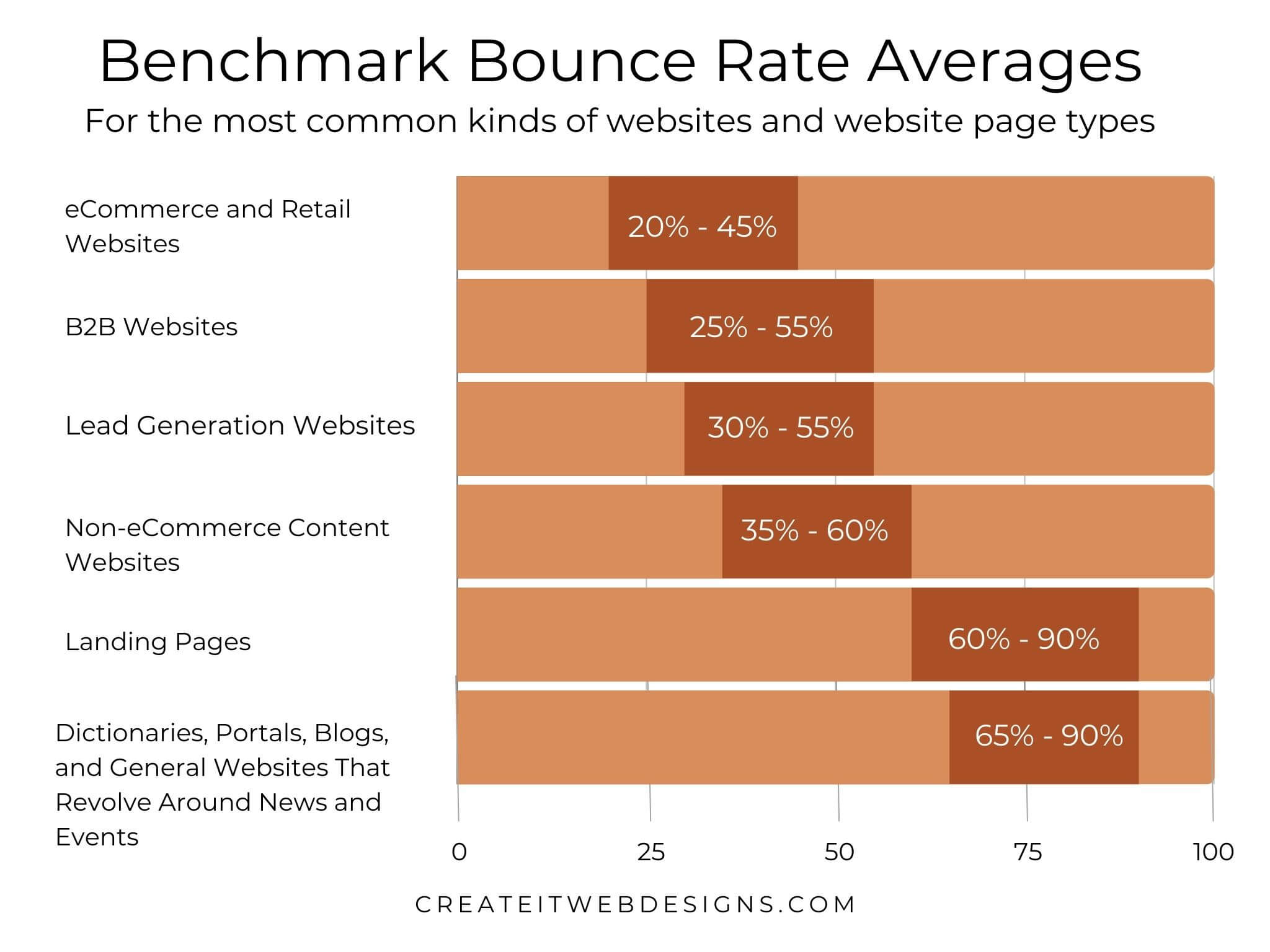A high bounce rate is an indicator that your website’s content and layout are not enough to keep visitors interested.
Let’s discuss the truth about your website’s bounce rate, what it means when you have a high bounce rate, how to improve your site’s bounce rates with good design and content, and much more. Let’s dive in.
Table of Contents
What is a Bounce Rate? The Bounce Rate Defined.
Google simply states, “A bounce is a single-page session on your site.” Bounce rate is the percentage of visitors to a particular website who navigate away from the site after viewing only one page without performing any action such as clicking on a link, purchasing a product, or filling out a form.
A bounce rate is an indicator that your website’s content and layout are not enough to keep visitors interested on that particular page to either take action or visit other parts of your website.
How is bounce rate calculated?
Google Analytics calculates bounce rates by tracking every single hit on your site. This allows you to see how many times a visitor comes onto the site, views one page, and then leaves without viewing any other pages or performing an action like clicking on links or filling out forms.
Examples of Actions That Cause Bounce Rates
What specific actions can cause a user to bounce from a page?
- Closing the browser tab or window
- Entering a new URL in the search/address bar
- Clicking on an outbound link
- Clicking the browser back button
- Staying inactive for more than 30 minutes and the session times out
- Reading the entirety of a page but not triggering any events, and then leaving
What Bounce Rate is Good?
It’s important to remember that each site has its own definition of what constitutes the definition of a “good bounce rate.”
A high bounce rate in general means that you are losing visitors. In general terms, anything over 90% is considered too high of a bounce rate and anything below 25% is also considered problematic. 25% – 90% is a large range, but there are multiple factors that need to be considered such as the niche industry of the website and the type of web page.
The best way for you to determine if your website has a high bounce rate depends on what type of website you’re running and how popular that site is in the industry.
The statistics by Custommedialabs shows the ideal bounce rate by industry and web page type
Here are some benchmark bounce rate averages for the most common kinds of websites and website page types:

- 20% – 45% for eCommerce and retail websites
- 25% – 55% for B2B websites
- 30% – 55% for lead generation websites
- 35% – 60% for non-eCommerce content websites
- 60% – 90% for landing pages
- 65% – 90% for dictionaries, portals, blogs, and general websites that revolve around news and events
What Causes a Low Bounce Rate?
A low bounce rate, on the other hand, can be good or bad depending on your goals and what you’re trying to accomplish with your website.
Having a low bounce rate means your website has the ability to keep users interested by providing engaging content and calls-to-action so they continue browsing through other pages. But it could also mean that you are not driving enough traffic to your website to try and bring in more of your ideal viewers. Just because you have a low bounce rate, doesn’t mean you are bringing in enough potential leads to build more customers.
On the other hand, a bounce rate that low may also reflect a lack of dynamic content (blogs, news, etc.) on the website, possible issues with Google Tag Manager (usually it’s double embedded), or chat boxes showing action when there is none.
The more well-researched and SEO optimized blog articles on the website, the better it is to bring in more traffic to your website and convert them to leads and/or customers.
What Causes a High Bounce Rate?
A bounce rate that’s too high can most likely be attributed to a lack of dynamic content, meaning you’re not offering the kind of information your visitors are looking for.
There are many reasons why your website might be experiencing a high bounce rate, some of which you can fix yourself while others will require the help of web professionals like web designers and SEO specialists. Let’s take a look at some common factors that contribute to low-quality traffic:
- Bad design
- Not enough white space
- Low quality or irrelevant content on your website.
- Slow website (desktop and mobile)
- Not mobile-friendly
- No clear calls to actions
- Aggressive pop-ups
How to Improve Your Website’s Bounce Rate?
A high bounce rate is usually a result of bad design and it’s important that you first fix the issues with your website before worrying about other factors. In addition, here are some simple ways for you to make improvements on your site:
- A solid web design with white space
- Improve page speed (both mobile and desktop)
- Add more engaging content
- Update your current articles with updated information and to be more engaging.
- Add calls-to-action
- Make sure your site is mobile-friendly
- Add a blog sidebar
- Increase internal links in your blog articles
- Have a simple and clear menu and site structure
- Remove or improve low-quality or irrelevant content on your website–this includes removing blog articles that are not bringing in traffic or are no longer relevant.
Sometimes the best course of action is to invest in a brand new website. If your website is more than 3 years old, you are most likely ready for a new website. Starting with a fresh design can be key to driving in more traffic and meeting your goals.
Is Bounce Rate a Ranking Factor?
Bounce rate is an SEO ranking factor but not the way you think. Google doesn’t look at the magic “bounce rate” number and automatically think “low is good”. Bounce rate may be an indicator of other SEO issues, such as page speed, mobile speed, core vitals, poor copywriting, or bad design.
So, when bounce rate is said to be an SEO ranking factor, it’s not a checkbox.–it’s a clue to the entire website structure. Google’s search algorithm is complex, so I tell my client’s a high bounce rate does not always necessarily mean a problem.
On June 12, 2020, Google’s John Mueller, a well-known Google Webmaster Trend’s Analyst who gives us more clarifying statements about Google’s Algorithm, confirmed that Google does not use bounce rate as a ranking factor in a Google webmaster hangout. “I think there’s a bit of misconception here that we’re looking at things like the analytics bounce rate when it comes to ranking websites, and that’s definitely not the case.”
Do high bounce rate websites display well in Google search–yes, if the page speed is fast and Google likes the article. Do low bound rate websites also display well in Google search–again, yes, if the page speed is fast and Google likes the article.
Focus on the content that your viewers want.
Bounce Rate Benchmarks
If the success of your website depends on users viewing more than one page, then you need to focus on a good benchmark bounce rate range.
For example, if the home page is the gateway to the rest of your site (which a majority of websites are) then the blog, about, services, products, checkout, then you don’t want a high bounce rate.
On the other hand, if you have a single-page site such as a blog, contact forms, confirmation pages, and other landing pages in which single-page sessions are expected then a high bounce rate is perfectly normal.

What is the Exact Bounce Rate Benchmark to Work Towards?
It is important to set a baseline benchmark goal and work towards improving the bounce rate rather than solely meeting “standard benchmarks.”
The question you should be asking is not “what is the average bounce rate?” but “how can I improve my current bounce rate?” or “how can I drive more traffic to my website?”
The averages provided in this article are a good starting point to gain a broader overview of bounce rates. Setting your baseline goal and forming an action plan takes a bit more effort whether you do it yourself or hire a professional.
Increase Your Website’s Bounce Rate and Conversion Rates with Good Design and Quality Content
If you have a great well-designed website, with great, informative, and helpful content on a high-speed web host, set a good goal for a bounce rate benchmark.
If your struggle with your website and content, it may be time to invest in your website by either creating a new website or fixing the issues with your website.
By setting your bounce rate benchmark goal, don’t get lost in your ultimate goal–which is to bring in more traffic and increase your conversion rate. Everything should be focused on that piece.
The bounce rate helps determine where those issues might be on your website.







